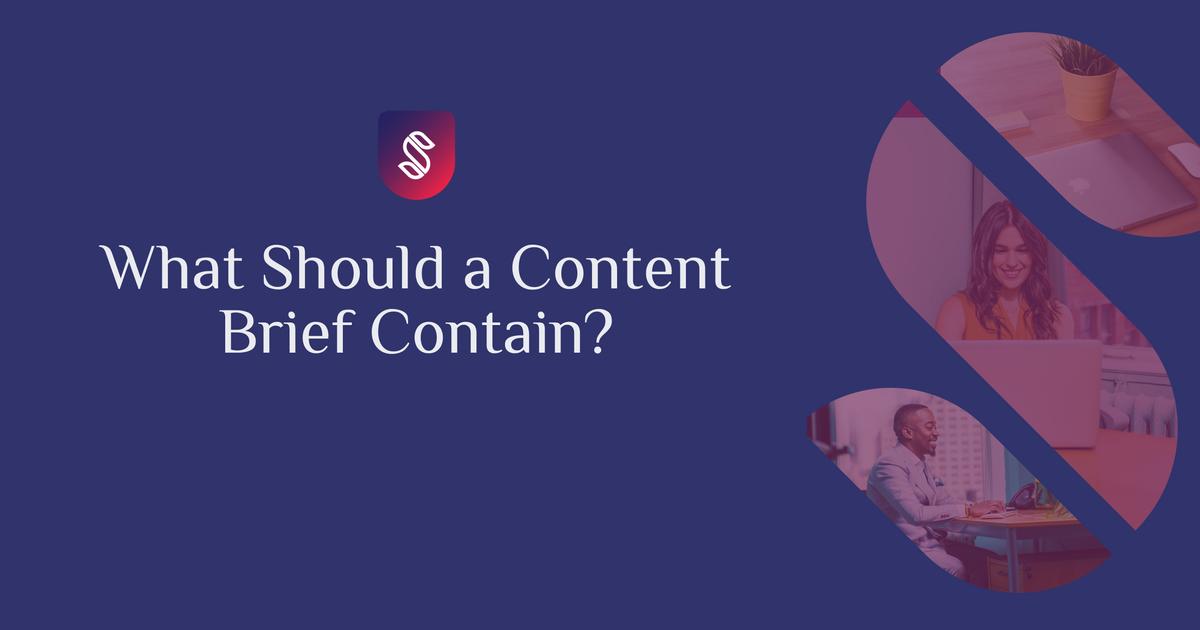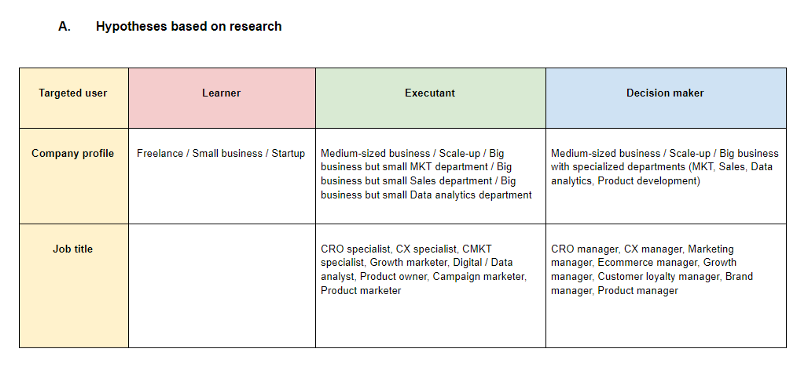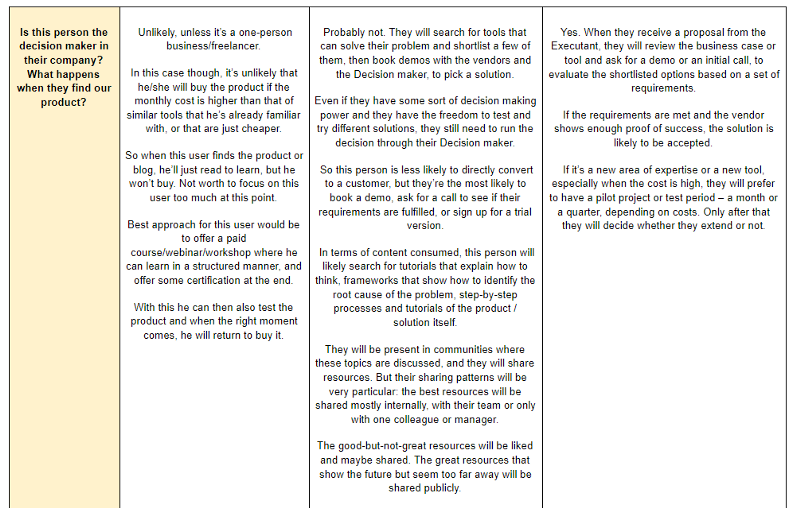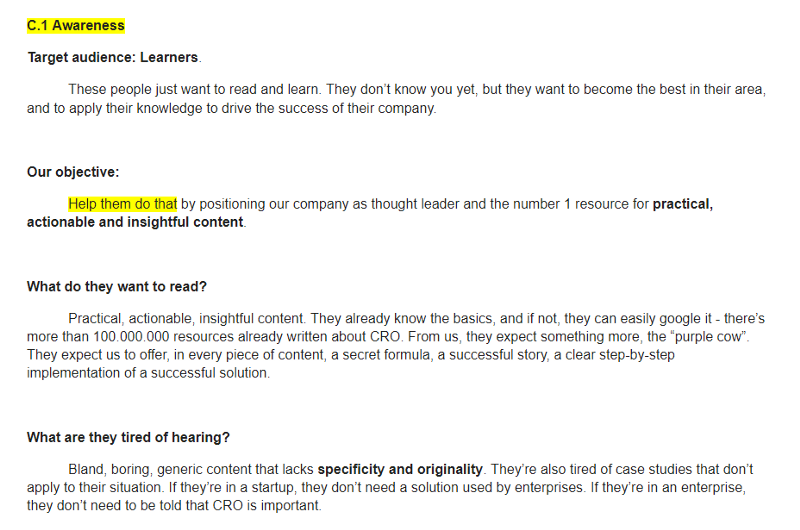Written on 23rd December, 2020 | 7 min read
What Should a Content Brief Contain? Example from a SaaS Business
Areas to cover in a brief for your content writers, including what to look for when researching your audience.
Andreea Macoveiciuc
Strategist @School of Content

If you’re a content strategist or content marketing manager looking to scale up your content production, you’ll face these challenges:
finding and hiring good writers
onboarding them — helping them get familiar with your company’s services or products, main USPs, competitors, target segments, and your tone of voice and writing style
putting together a coherent strategy to let them know what’s next and what goals they’re working towards
helping them create good content by providing effective content briefs
I’ll cover the last point here and we’ll address the other topics in separated pieces, so make sure to bookmark this article as a reference.
Let’s first expose the elephant in the room and look at the purpose of a content brief and the consequences of not having a brief or outline for your next planned article.
What a content brief is and isn’t
A content brief is meant to help your writers create content that will:
help you meet your marketing goals, by
helping you turn visitors into customers
That’s the ultimate goal of content marketing if you’re doing it professionally: to get clients for your business.
So your content brief needs to help your writers get into the mind of the customer and understand what they want or need to read in order to buy a product or service from you.
A content brief is a skeleton or outline that tells your writers enough about the target audience, the topic of the article, the angle to take, and the context to create in order to make that conversion likely to happen.
A content brief is not a list of keywords ranked by traffic potential. A useful content brief is not a huge strategy document linking to your PPT presentations of personas, themes, or services.
A content brief it’s called a brief for a reason, jongens :)
It should be:
brief,
to the point,
and helpful
If your writers read it and don’t get clarity on what they need to write about, how they need to approach the topic, and what they need to achieve with that piece, you’re not writing effective content briefs.
Two common mistakes when creating content briefs
The most common mistakes that make a content brief less helpful are:
assuming that your writers will figure things out and do the extra research to fill in the gaps
assuming your writers are stupid so they need a ton of information in order to create a piece of content
The first mistake is commonly done by consultants and managers who don’t like to be bothered with details.
They never wrote an article themselves, so they have no idea how to do it. They just know it should include some keywords and help them rank, convert, and so on.
Here’s the really bad news: your writers won’t have the time for extra research, and it’s not their job to do that. Surely, they should research the topic, but they shouldn’t have to do the entire audience, competitor, and industry research from scratch for every piece of article.
That’s the role of a content strategist. And that research needs to be done before any piece of content is created.
The second mistake is done by perfectionists who think they’re the only ones who can write good content. It’s super easy to fall into this trap if you’ve been writing for a few years and then moved into management or strategy.
If your writers are taking a lot of time to start drafting a piece of content, your guidelines are probably too overwhelming. So don’t expect your content writers to create the exact piece of content that you would create.
They won’t be able to guess your words and read your thoughts, but there’s no need to explain all your thoughts and how you would do it in the brief. If it takes you 1 hour to write a content brief, you can probably draft the article yourself.
Both these mistakes can be avoided with a simple and useful exercise that should take place before creating a single content brief: developing your content strategy.
Once you have your strategy in place and your writers are familiar with it in big lines, you don’t need to educate them and repeat the story in every brief.
So let’s look at the pre-work, or the minimum amount of research that you should do before writing a brief for content marketing.
The pre-work: what to do before writing a content brief
While developing your content strategy, you’ll identify a couple of themes or topics that you must own. These are themes that you want to be known for, found for, and considered the ultimate authority on.
These themes will very likely be turned into content series or campaigns, so they’ll be split into multiple topics that will be covered throughout the year.
These topics will fill your content calendar and keep you focused on creating content that’s meaningful for your audience and business.
So your pre-work should include researching these themes and understanding the purpose and context of each series.
Let’s take a practical example to make this easier to understand. This is a content series for a SaaS company in the CRO space.
You can check the template here:
Research for content series — an example from a SaaS company
This document will include three main sections:
Hypotheses based on our own audience and topic research,
Data from real customers / CRM,
Topics to write about and angle

Image: content-brief-example
In this first part, we want to include:
the target user: learner, executant, or decision-maker?
the company's profile
the job title
how do they find the product?
what happens when this person finds our product?
what were they searching for, what’s their pain point?
what’s the user intent?
what’s the user preferred solution?
what are their rejection arguments?
what is our message?
what is our solution, what does it do for them?
what’s our CTA?

Image: example content brief research
In the second section of the document, we’ll include real data from the CRM, from sales calls, chat support tickets, and so on.
In the last section of the document, we’ll add the themes to write about for every stage of the funnel, and the angle to take.

Image: example audience research for content strategy
You can see the full document here:
Example of research for content strategy & content brief
Now that our research work is done, we can share this document with the content writers, before creating briefs for specific articles or content pieces.
So let’s now move to the actual content brief and look at a practical example.
Content brief example — how to write an effective content brief
We’ll use the research document and prepare a brief for an article targeting the learners, for the awareness stage.
Here’s what the content brief will include:
the stage in the funnel
the target audience
the user intent
our objective
what do they want to read?
what are they tired of hearing?
what content will help us stand out?
Here’s the practical example: Content brief example (Google Docs)
[Working title]
Stage in the funnel: Awareness
Target audience:
Learner — freelancer or part of small business. He wants to read, learn, and apply the advice to improve [a specific metric] for his website.
User intent — will he directly buy a plan?
No, he’s here to learn so the purpose of this article is to show him that he can trust us not only because we're the creators of the best tool, but also because we offer the best learning material on the topic.
Our objective:
Help the user achieve his goal while retaining him. He won’t buy yet, but we want him to think of us as the go-to resource for this topic.
We want to upsell the course once he shows interest by subscribing or following, but we don’t do a hard upsell in this article.
What does he want to read?
Practical, actionable, and insightful content in a step-by-step format. Show him how to [do specific action] with our tool — where to go, what to press, what to filter, how to think about it.
What is the user tired of reading?
Bland, boring, generic content that lacks specificity and originality. He doesn’t need the big picture, a generic article that tells him what to do. He doesn’t need the strategy behind it. He just wants to understand how to [do the action], step by step, with pictures and clear explanations.
Which content will help us stand out?
In-depth and actionable content that details the process and shows how the user can apply it to his business.
If we list a step, we detail it and show the tools used, the thinking process behind the step, the common mistakes, and how to avoid or fix them.
If we link to resources, they need to make sense. We don’t link to irrelevant data just to have some statistics thrown in. We don’t want to overwhelm the user and send him away.
Who do we need to outrank in order to be found by this user?
[ List the top 3 articles ranking for your main target keyword ]
[ How are these articles structured? Main sections]
[ What angle do they take? ]
[ Can we take a different angle, and write a title that meets the search intent, while creating some confusion / intriguing the user? ]
NOTE: The keyword research itself doesn’t have to be included in the content brief. This is something that you do beforehand and is part of your content strategy/taxonomy.
In a content brief, you include only the main keyword to target and its variations, if they’re relevant. If your writer uses a tool for content creation, they’ll get suggestions for other keywords to include.
What I don’t include in the content brief
I like to keep the content briefs clean and clear and to only include there the actual content-related information, not the project management stuff.
So I don’t include things like a deadline, type of content (blog article, video, e-book, guest post, etc.), as these are already mentioned in the content planning tool. If you use Airtable, Asana, Podio, or similar tools, it’s easy to keep this information as structured data about your content.
I do include the funnel stage and persona, to keep the writer focused on the goal of the content and who it’s aimed at.
I only list 3–5 keyword variations — the rest will very likely be covered anyway by a well-written article, so the context will naturally be created if the piece is written with the audience and their needs in mind.
I don’t include the structure of the article in the brief, but I might mention the main sections or the preferred outline. However, in most cases, listing the top 3 articles that rank for the target keyword is enough for understanding what structure to use and what sections to cover, more or less.
The structure and table of contents are likely to change based on the writer’s inspiration and knowledge of the topic, so I find it more efficient to let them write without providing a structure that’s too stiff.
I also don’t include graphics or tone of voice in a content brief. Your writers should be familiar with your tone of voice from your content strategy document.
Graphics are typically done after the content unless it’s a data-rich piece. In that case, sharing the link to the raw data is more useful.
I hope this is helpful!
If you need help in developing a content strategy or improving your content briefs, get in touch with our team!